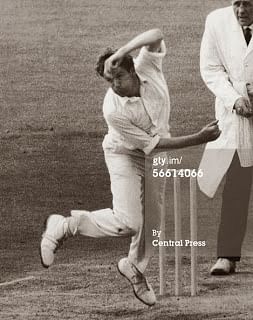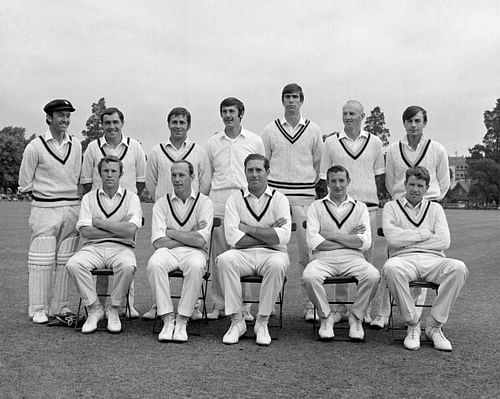
An interview with Harold Rhodes: part 2

(Part 2 of an ongoing series)
How did Les Jackson and Cliff Gladwin help you develop? I presume they had more to do with your development than Denis Smith, who was a batsman?
It wasn’t so much coaching, as assimilating what you saw and heard. At Wellingborough, in my first season, Frank Tyson steamed in for Northamptonshire and bowled a bouncer first ball to John Kelly. It went over his head, on a rock hard track, then over the head of Keith Andrew, who was keeping wicket twenty yards back. It hit the middle of the sight screen on the full – quite extraordinary!
I turned to Cliff, who was sat alongside me on the pavilion balcony. “Did you see that?” I said.
“Aye” said Cliff, “What a waste of a new ball…”
You had to learn from such people, they just knew so much. It was the same around the circuit and I listened to the likes of Brian Statham at Lancashire, who liked a pint at the end of a hard day. “They miss and I hit” was his motto – and he usually did!
Tell me about them as people. How did you find Cliff and Les, on and off the pitch?
Cliff was short-tempered and could be unbearable at times if he got his dander up. You dreaded dropping a catch off his bowling, as you’d be called all sorts of stuff. He was a wonderful senior professional though and the discipline when he played was first-class. That kind of thing is often overlooked in its importance.
He bowled big in-swingers but cultivated a leg-cutter that kept batsmen guessing. He was the opposite of Les, who was really laid-back and just shrugged his shoulders if the ball was dropped. He’d usually just say “Catch next ‘un” and carry on.
Les was a seam bowler and moved it off the seam. Even on flat wickets he got movement and he should have played for England for years. No one liked facing him, but his ‘slinging’ action had no fans among the purists at Lords. They preferred to pick blokes who had nice actions but got far fewer wickets and were less rated around the county circuit.
When I made my Test debut, Fred Trueman said that I had done well, because you needed to be at least ten per cent better than anyone else to get a game for England when you played for Derbyshire. That’s what counted against Les. He was a wonderful bowler and a lovely man. It was a privilege to be in the same team.
For the benefit of younger fans, who in the modern era were they like from a pace perspective?
Les was quick and awkward. He’d have been bowling at top 80′s mph. He got remarkable pace and lift from what was a kind of round-arm sling. Batsmen were always getting hit on the hands or inner thigh and his bouncers, such as they were, used to spear in at batsmen’s ribs and chest. He wasn’t easy to play and I suppose you’d say that he was around the pace of the likes of Anderson and Broad today. When you’d faced Les on a green top you certainly had the bruises to prove it!
Cliff was a good bit slower, maybe bowling around 70mph, but he got late movement and was backed up by some wonderful fielders in the leg trap. They held some amazing catches, as Cliff darted it around. On a helpful track he fancied his chances of getting anyone, either in that leg trap, or in the slips as he moved one away off the seam.
Why didn’t Les play more games for England?
Snobbery. That’s it in a nutshell. The big-wigs at Lords didn’t like his action and assumed that he wouldn’t take wickets at international level because of it, which was stupid. Year in, year out, Les took over a hundred wickets. They said that he only took them on Derbyshire green tops, but the statistics showed that he took as many, if not more, away from home.
Trueman, Tyson and Statham were all fine bowlers throughout the 1950′s and the quickest bowlers on the circuit, but they knew that whatever they could do on a county wicket would be replicated by Les. The likelihood was that he’d have done exactly the same in international games.
He should have played many more times for his country, but it was the usual anti-Derbyshire bias.
What was life like for a professional cricketer in the ’50s?
Very different! I started as a junior professional, of course and we usually travelled to away matches by train. My job at that time was to get the bags to the station – which required two taxis – and then needed two trolleys at the station to get them on to the platform and then on to the train. You needed to keep change handy for tipping porters and then ensure that everything came off the train at the other end. I’m proud to say that I never lost a bag!
When we played in Essex or Sussex, there could be two or three different trains to catch, so you can imagine it was a lively time. We used to play cards on the train and no one ever bothered us, even if we were recognised. To be fair, few people did recognise you at that time, as it pre-dated the current ‘celebrity’ culture.
There were relatively few cars on the road at that time and only a few old ones among the team, The only time we travelled by car was for the local games at Nottingham, Leicester and Birmingham. We used to get £8 a night expenses for away games, which covered your room and meal. We used to travel home each night, so at the end of the match we were £24 better off and lived like millionaires for a few weeks!
Peakfan note – the purchasing power of £24 in 1957 is around £450 today…
At what point in your development did you realise that you could make it in first class cricket?
I suppose it was in my first season. I took over seventy wickets at a low cost in that summer and I bowled consistently throughout. At the end of the summer, Cliff announced his retirement and said that I would be an excellent replacement. I couldn’t have wished for a greater commendation than that, really.
To be continued…